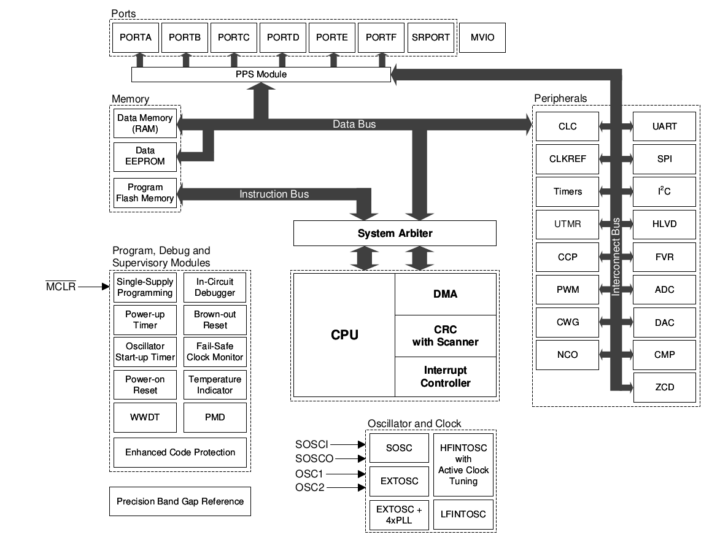The newly introduced Microchip PIC18-Q24 8-bit MCU implements security measures such as the Programming and Debugging Interface Disable (PDID) feature and optional support for an immutable bootloader, as well as support for Multi-Voltage I/O (MVIO) to interface with digital inputs or outputs at different operating voltages without the needs for level shifters.
While it’s fun to find a new MCU platform that you can hack via serial, JTAG, or other debug interfaces, it can be a security issue, and the Microchip PIC18-Q24 aims to make that impossible by disabling programming and debugging interfaces and the 8-bit microcontroller also offers an option to make the bootloader impossible to modify once a specific configuration bit has been set.

Microchip PIC18-Q24 key features and specifications:
- MCU core – 8-bit C compiler optimized RISC core @ up to 64 MHz
- Memory – Up to 4 KB of Data SRAM Memory
- Storage – Up to 64 KB of Program Flash Memory, 512 Bytes Data EEPROM
- Multi-Voltage I/O (MVIO) for support for a second voltage domain (VDDIO2) set within a 1.62V to 5.5V range
- 4x Direct Memory Access (DMA) Controllers
- Vectored Interrupts
- 128-Level Deep Hardware Stack
- Digital Peripherals
- 3x 16-Bit Pulse-Width Modulators (PWM):
- Timers
- 3x 16-bit Timers (TMR0/1/3)
- 3x 8-bit Timers (TMR2/4/6) with Hardware Limit Timer (HLT)
- 2x Universal Timers (TU16A/TU16B)
- 2x 16-bit timers can be chained together to create a combined 32-bit timer
- Windowed Watchdog Timer (WWDT)
- Configurable Power-up Timer (PWRT)
- 8x Configurable Logic Cells (CLC)
- 1x Complimentary Waveform Generator (CWG)
- 2x Capture/Compare/PWM (CCP) Modules with 16-bit resolution for Capture/Compare modes, 10-bit resolution for PWM mode
- 1x Numerically Controlled Oscillator (NCO)
- Programmable CRC with Memory Scan
- 2x UART, 2x SPI, 2x I2C (SMBus, PMBus Compatible)
- 1x 8-Bit Signal Routing Port Module:
- Device I/O port Features
- 24x I/O pins including four MVIO pins powered by VDDIO2 (PIC18F24/25/26Q24)
- 35x I/O pins including 12 MVIO pins powered by VDDIO2 (PIC18F45/46Q24)
- 43x I/O pins including 12 MVIO pins powered by VDDIO2 (PIC18F55/56Q24)
- Peripheral Pin Select (PPS) – Enables pin mapping of digital I/O
- Analog Peripherals
- 10-bit Analog-to-Digital Converter with Computation (ADCC) for up to 30 external channels, up to 300 ksps
- 8-Bit Digital-to-Analog Converter (DAC):
- 2x High-Speed Comparators (CMP)
- 2x Zero-Cross Detect (ZCD) modules that can detect when AC signal on pin crosses ground
- Voltage Reference – Fixed Voltage Reference with 1.024V, 2.048V and 4.096V output levels
- Enhanced Code Protection
- Programming and Debugging Interface Disable (PDID) through the ICSPDIS Configuration bit
- Storage Area Flash (SAF) one-time programmability through the SAFLOCK Configuration bit
- Reset
- Low-Current Power-on Reset (POR)
- Brown-out Reset (BOR)
- Low-Power BOR (LPBOR) Option
- Programming/Debug Features
- In-Circuit Serial Programming (ICSP) via 2x pins
- In-Circuit Debug (ICD) with 3x Breakpoints via 2x pins
- Debug Integrated On-Chip
- Voltage Range
- VDD – 1.8V to 5.5V
- VDDIO2 (Multi-Voltage I/O) – 1.62V to 5.5V
- Power Saving modes
- Doze – CPU and Peripherals Running at Different Cycle Rates (CPU Is Typically Slower)
- Idle: CPU Halted While Peripherals Operate
- Sleep: Lowest Power Consumption
- Peripheral Module Disable (PMD) – Ability to selectively disable hardware modules to minimize active power consumption of unused peripherals
- Low Power Mode Features:
- Sleep: < 1 µA typical @ 3V
- Operating Current: 48 µA @ 32 kHz, 3V, typical
- Package – 28-pin SPDIP/SOIC/SSOP/VQFN, 40-pin PDIP/QFN, 44-pin TQFP, or 48-pin TQFP/VQFN
- Temperature Range – Industrial: -40°C to 85°C; extended: -40°C to 125°C
There are currently seven different devices with variations in terms of flash and SRAM capacities, as well as different I/Os depending on the selected package. Microchip says the new PIC18-Q24 microcontroller family is especially useful when used as a “system management processor, performing monitoring and telemetry for a larger processor”.
The new PIC18-Q24 microcontrollers are supported by MPLAB Code Configurator (MCC) and the usual ecosystem of development tools for Microchip microcontrollers. Thecompany also provides the PIC18F56Q24 Curiosity NanoEvaluation Kit (EV01E86A) for testing and early software development.

Pricing starts at $1.18 per unit for the PIC18F24Q24-I/STX for orders of 100 pieces or more. The PIC18F56Q24 Curiosity NanoEvaluation Kit can be purchased now for $24.02 on the Microchip Direct website. Further information may be found on the product page and in the press release.
Thanks to TLS for the tip.

Jean-Luc started CNX Software in 2010 as a part-time endeavor, before quitting his job as a software engineering manager, and starting to write daily news, and reviews full time later in 2011.
Support CNX Software! Donate via cryptocurrencies, become a Patron on Patreon, or purchase goods on Amazon or Aliexpress





